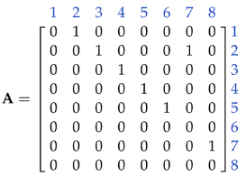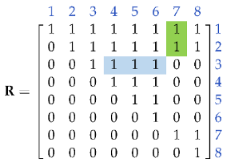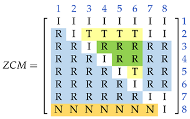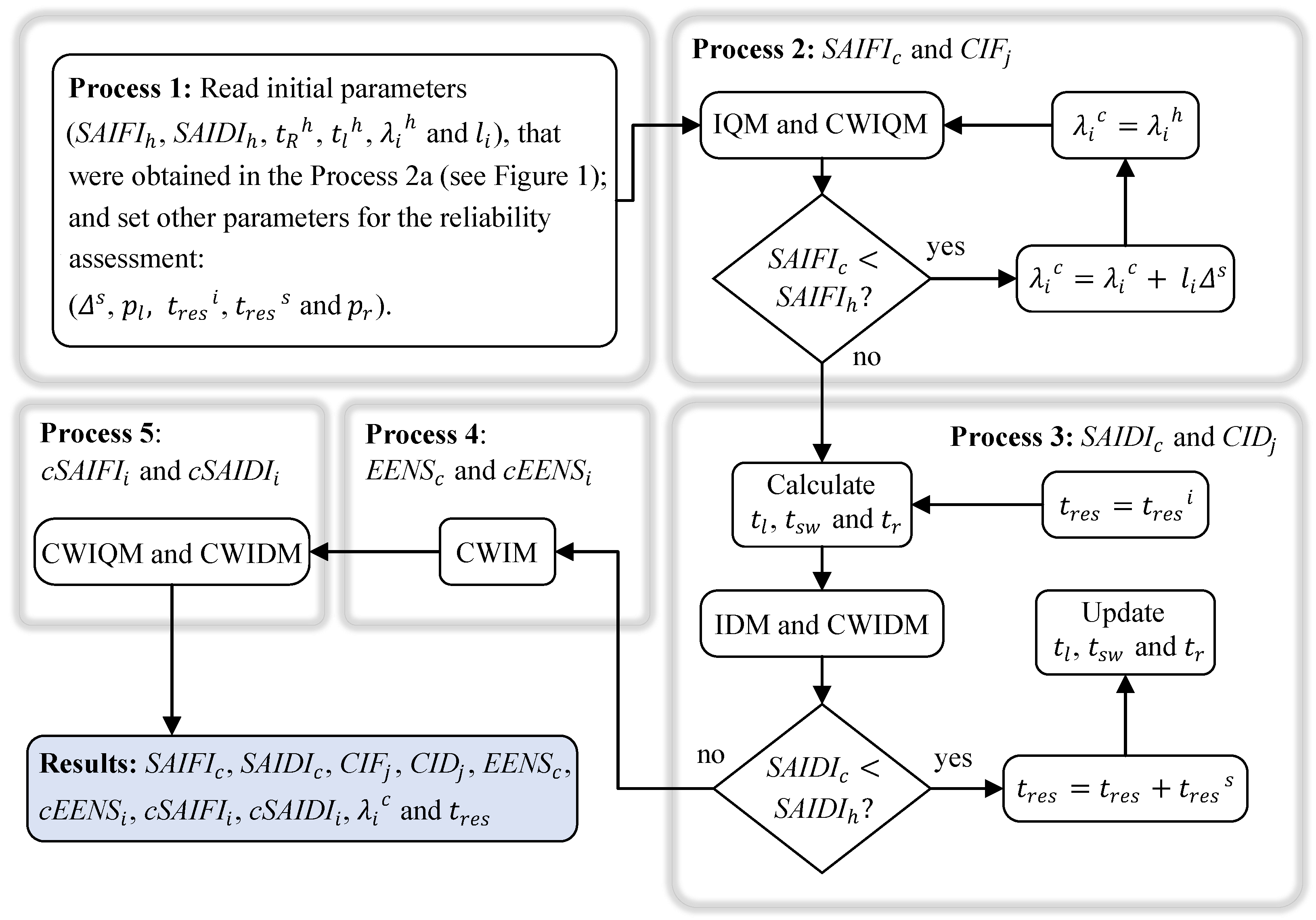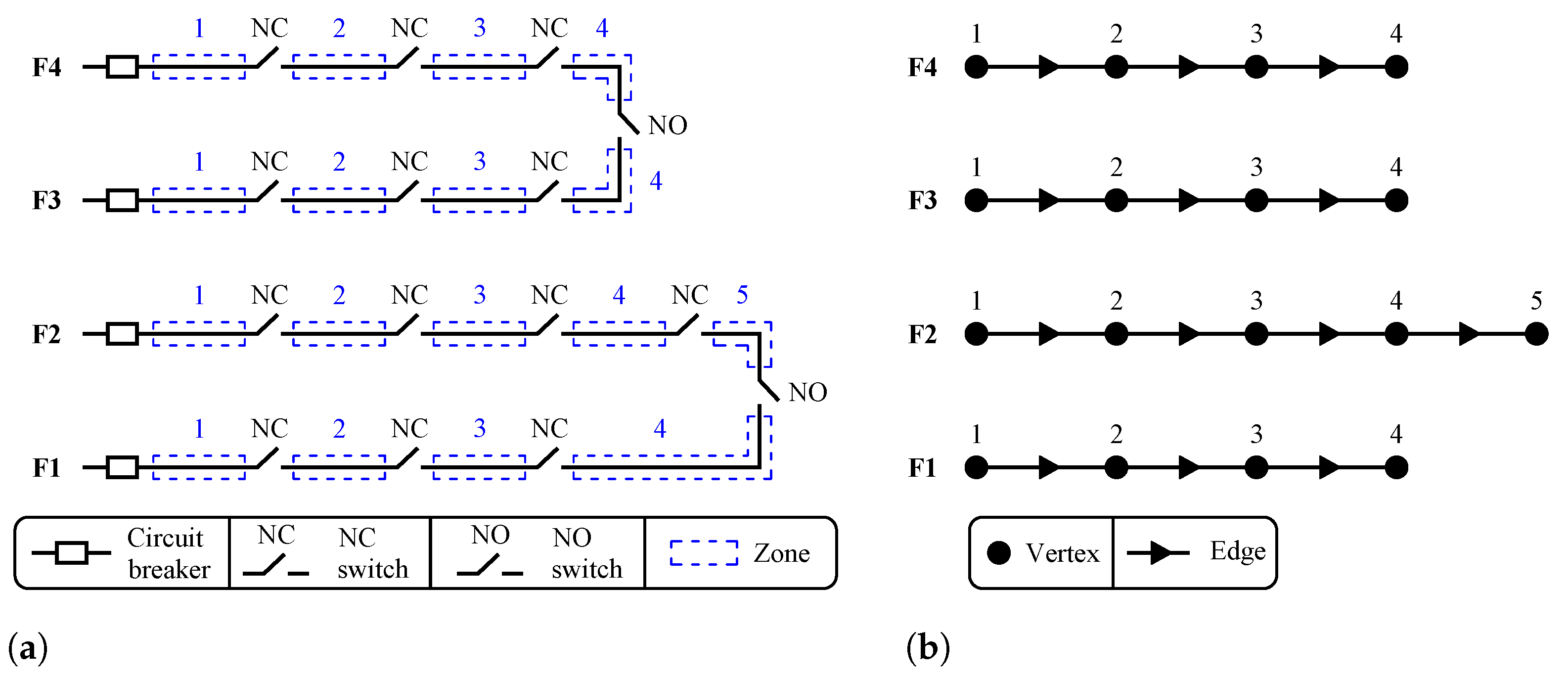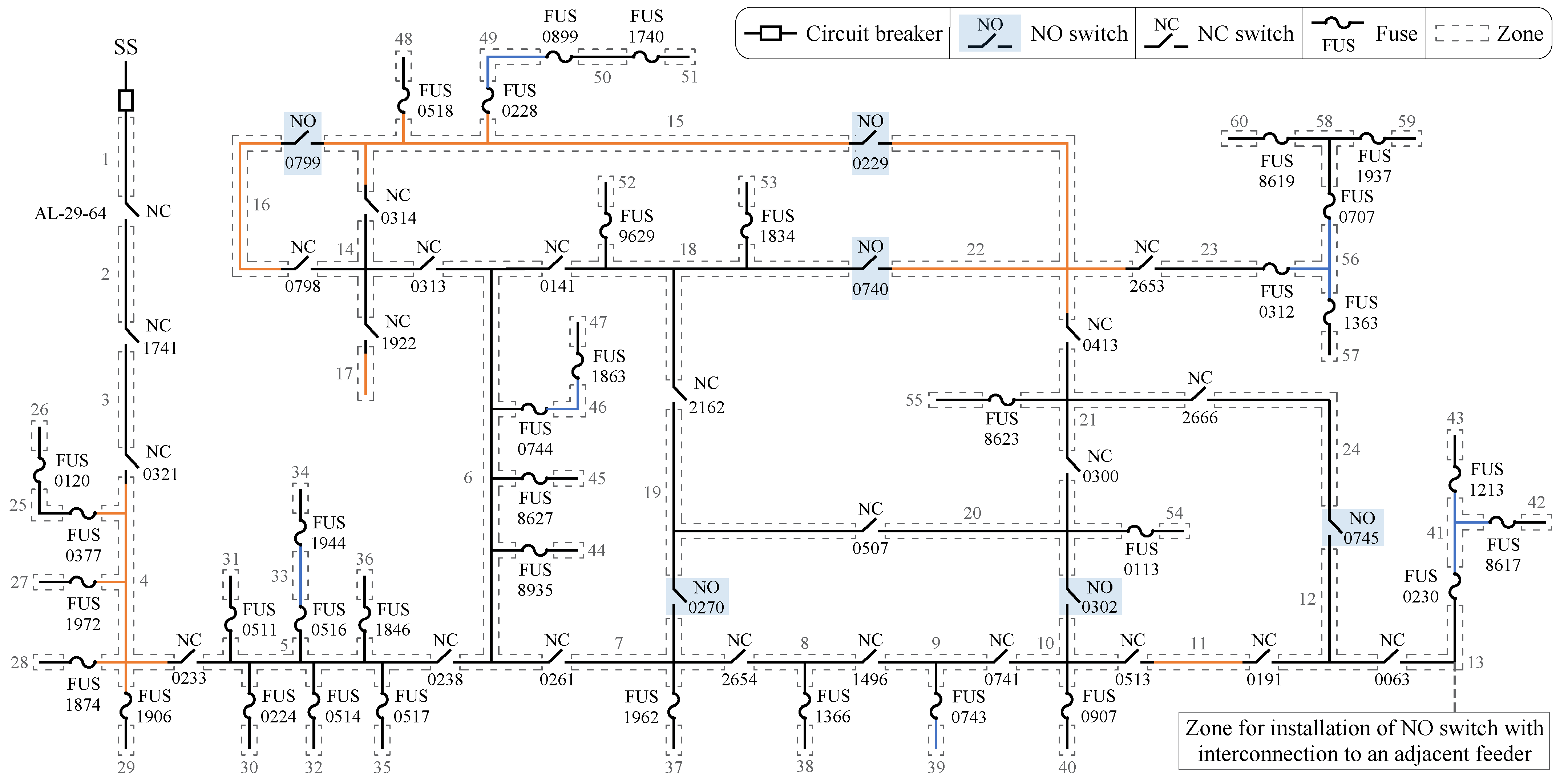1. Introduction
Nowadays, great interest resides in the study of the quality of electricity supply, since it is related to technical and economic losses affecting utilities and end-users [
1]. In this respect, the services offered by power distribution companies have to meet quality requirements imposed by regulatory agencies. As a consequence, power distribution companies in general follow given strategies when they plan the operation and the expansion of their distribution network. In addition, new solutions are constantly needed to modernize the distribution network and simultaneously assure high-quality services [
2,
3,
4,
5]. On the other hand, low investment costs in the network compete with improvement in reliability indices, making thus necessary support tools to define those projects that best improve reliability at the lowest cost [
6]. Therefore, the essential aspects to be considered to make decisions on the expansion of the system are (i) estimation of the reliability indices, (ii) identification of the points of the network that most need improvements, and (iii) the assessment of the impact of expansion projects on reliability [
7]. In this context, it then becomes relevant to develop software tools to support power distribution utilities to better choose expansion projects during the planning stages.
Reliability can be measured using several indices, such as the system average interruption duration index (SAIDI), system average interruption frequency index (SAIFI), average service availability index (ASAI), customer interruption frequency (CIF), customer interruption duration (CID), and expected energy not supplied (EENS) [
8,
9,
10]. These indices are related to frequency, duration, or energy not supplied due to interruptions. In addition, SAIFI, SAIDI, and EENS are among the commonest reliability indices used by power distribution companies [
11].
Reliability indices can be obtained through analytical methods or simulation, such as the Monte Carlo Simulation [
6,
12]. Analytical methods represent the system through analytical models leading to analytical solutions, from which the reliability indices are estimated. In contrast, methods based on Monte Carlo Simulation estimate the reliability indices by simulating the random behavior of the system [
13]. Furthermore, analytical methods generally provide average values for reliability indices, whereas methods based on simulation provide probability distributions of possible values of the reliability indices [
14].
Analytical methods for reliability assessment require lower computational effort to estimate reliability indices when compared to methods based on simulation [
6,
15]. In addition, analytical methods can be readily applied to real distribution systems, given that distribution utilities usually have feeder models suitable for some commercial software used for network analysis. Moreover, this type of method is more adequate for sensitivity analysis due to the better accuracy of the results that can be obtained [
14]. Hence, reliability assessment based on analytical methods can be considered more suitable for application to real systems.
The specialized literature exhibits many studies addressing the reliability of large power distribution systems (PDS), of which the most relevant are discussed in what follows. In [
16], a reduction in the computational time needed to analytically evaluate the reliability was obtained through an algebraic formulation in which a system of linear equations is solved. The author of [
17] analytically assessed reliability indices using graph theory and historical data of interruptions of a real distribution network. Besides, in this work, the planning of automation of switches of the primary distribution network was defined through an optimization model. A method based on the fault incidence matrix (FIM) was introduced by [
18] for the analytical estimation of the reliability of PDS. Although the method proposed in [
18] can be used to analyze the sensitivity of reliability indices aiming to reduce the computational load, it has not been yet applied to real or large systems. A more recent paper presented an extension of the FIM along with mathematical expressions to quantify the impact of some factors that affect reliability [
19]. This study was applied to a real system, showing its potential to contribute to reliability improvements. We highlight that system planners are nowadays concerned with the assessment of the reliability of large systems, which is explained by the difficulties with the modeling and numerical complexity of such assessment. In addition, modeling of additional resources related to network reconfiguration becomes necessary so as not to overestimate the reliability, which can introduce more computational difficulties. Although the methods proposes by [
16,
18] are suitable for reducing the computational load required for reliability assessment, both works disregarded the impact that expansion projects can have on reliability.
The problem of planning the expansion of PDS with a focus on improvements in reliability is usually treated as an optimization problem, in which the reliability is considered through a multi-objective function or a weighted single-objective function [
7,
20]. Besides, the optimization problem considers expansion projects, which are defined by decision variables, such as the number and optimal location of protection and/or sectionalizing devices [
21,
22]. In this context, optimization models solved both through exact [
23,
24] methods and also approximate [
25] methods are found in the literature; these, however, are predominant over exact methods [
7].
The computational complexity of an optimization problem generally depends on the size of PDS being considered [
7]. Therefore, finding solutions to the problem with a reasonable computational load depends strongly on the dimension of the system. Large real systems can have no feasible solution, or the computational time to find feasible solutions may be too long, so that the use of optimization methods when planning the expansion of networks can become unpractical.
In some studies, reliability is assessed using solutions found for optimization problems used for planning the expansion of PDS. In [
26], a method was presented which includes the assessment of reliability in studies of planning the expansion of distribution systems. The proposed method was applied to evaluate the reliability using the solution found for the multistage optimization model proposed in [
27]. In yet another study, the authors developed a mixed integer linear programming (MILP) model to be applied to multistage expansion planning of PDS [
9]. Further, multiple solutions were obtained considering the multistage planning horizon and the estimated reliability was used to compare solutions. Although on the one hand, the solution of optimization models indicating the best expansion plan may be useful to make a decision, on the other hand, network diagnosis allows the identification of critical points of the network and thus help prioritize given expansion projects. Furthermore, the models described in [
9,
26,
27] cannot be applied to analyze the impacts of expansion projects on reliability, such as the installation of successive sectionalizing switches.
In addition to studies that propose (i) the assessment of reliability in optimization models for planning the expansion of PDS, and (ii) the evaluation of the reliability related to the optimal solutions found for network expansion, studies are also found in the literature that analyzes the sensitivity of reliability indices as well as the impact that the expansion projects can have on the reliability. In [
28], a method for evaluating the impact of expansion projects on reliability was described and subsequently applied to a real distribution network. This method is based on the parts of the distribution network between protection and/or sectionalizing devices, which can be called
zones. In [
19], an analytical reliability assessment method was proposed that helps identify those factors that most impact reliability, such as failure rates, switching and repair times, among others. However, [
19,
28] uses a failure rate given per length unity and equally distributed along the entire feeder which, however, can misrepresent critical zones of the network that could otherwise be prioritized regarding expansion and/or maintenance actions.
Although reliability assessment has already been used for sensitivity analysis and to quantify the impacts of expansion projects on PDS, most published works plainly disregard reliability when developing tools to plan the expansion of power distribution systems. To improve this aspect, we propose here an analytical framework to consider reliability criteria when planning the expansion of PDS. Toward this goal, we use data available to power utility and define procedures leading to reliability indices considering the effective execution of expansion projects and also without execution. To validate the proposed framework, as well as demonstrate its use, we applied it to the distribution network at bus 5 of the Roy Billinton Test System (RBTS) [
29], and to a real distribution network, with the results being subsequently discussed.
Contributions and Innovations
We propose in this article a comprehensive framework to evaluate the reliability of PDS and estimate the impacts that the execution of expansion projects produces on reliability indices. As one of the main contributions, we point out the process of adjustment of reliability indices, which are estimated from historical data of faults in each zone. A further contribution is that unlike [
19,
28], failure rates are determined considering (i) the length of each zone of the distribution network and (ii) the history of faults of each zone, thus allowing the identification of the most critical zones. Moreover, as yet another contribution, the proposed method allows the evaluation of SAIFI, SAIDI, and EENS, as well as the load node indices CIF and CID, both not considered by [
19]. Additionally, the proposed framework includes the evaluation of the impact on the reliability of expansion alternatives such as (i) installation of normally-closed (NC) sectionalizing switches, (ii) installation of normally-open (NO) switches with interconnection to adjacent feeders, (iii) automation of NC sectionalizing switches, and (iv) reconductoring by replacing existing bare conductors with covered conductors.
The main contributions of this work are the following:
A method to obtain the failure rate of each zone of the feeder based on historical data of interruptions;
A method to assess the reliability of primary distribution feeders through the indices SAIFI, SAIDI, CIF, CID, and EENS;
The identification of the zones of the primary distribution network that most contribute to the improvement of the indices SAIFI, SAIDI, and EENS, thus supporting the prioritization of expansion projects;
A novel formulation to estimate the impacts of expansion projects on reliability of primary distribution feeders.
3. Analytical Assessment of Reliability
The method we propose here to assess the reliability of primary distribution systems assumes that (i) no simultaneous faults occur, (ii) only permanent faults take place, and (iii) the current capacity of conductors and switches are not exceeded.
The analytical assessment of reliability is based on the classification of the zones regarding their capacity for restoration after a permanent fault in the distribution feeder. In this way, when a fault occurs in a given zone, the zones of the feeder are subsequently classified as follows.
Unaffected Zone (N): when the fault of a given zone does not interrupt the analyzed zone;
Recoverable Zone (R): when the fault of a zone interrupts the analyzed zone, but it is still possible to restore its supply through switching and re-connections within the same feeder;
Unrecoverable Zone (I): when the fault of a zone interrupts the analyzed zone with no possible restoration until the fault is fixed;
Transferable Zone (T): when the fault of a given zone interrupts the supply of the analyzed zone, but it remains possible to restore its supply by transferring the load to another feeder.
Now, using the matrix
and the classification described above, a matrix of classification can be defined, which will be termed Zone Classification Matrix (ZCM) and whose lines and columns of ZCM represent the zones of the feeder (Note that the lines represent the zones with fault). The matrix ZCM corresponding to the example feeder is given by (3). According to (3), the interruption of zone 7 interrupts all remaining zones of the feeders. However, the supply of zones 1 to 6 are restored by opening a sectionalizing device located upstream of zone 7.
From the matrix ZCM, it is also possible to obtain additional matrices with a similar structure which can be used to calculate reliability indices too, as proposed by [
28]. These additional matrices are called Interruptions Quantity Matrix (IQM), Consumers Weighted Interruptions Quantity Matrix (CWIQM), Interruptions Duration Matrix (IDM), Consumers Weighted Interruptions Duration Matrix (CWIDM), and Consumption Weighted Interruption Matrix (CWIM).
To obtain the interruption frequency indices, first, the matrix IQM, which indicates the probability of permanent faults, is built according to the classification of the zones of the feeder contained in the matrix ZCM. Those zones classified as N are null in the matrix IQM, as the supply is not interrupted in these zones. In contrast, the failure rate (failures per year) of the zone under fault () is assigned to those zones classified as R, T, or I.
In addition, through the matrix IQM, it is possible to obtain the index CIF of the consumers in each zone
j (
), expressed in interruptions per year. The index CIF is defined as the sum of the elements of each column of the matrix IQM as:
Each element of CWIQM contains the number of customers affected by interruptions in a year. The matrix CWIQM is obtained by multiplying IQM, element by element, with the respective number of consumers in the zone
j (
). The calculated SAIFI (
), in interruptions per year, is obtained as the quotient of the sum of all elements of CWIQM and the total number of consumers (TC) according to:
In contrast, the contribution of faults in zone
i to the
(
), in interruptions per year, is determined by the quotient of the sum of the elements of each line of CWIQM and TC:
The interruption duration indices are calculated based on the average restoration time (
), and on the following parameters: (i) average fault location time (
), (ii) average manual switching time (
) and (iii) average time to repair (
), all expressed in hours. Additionally, the percentage of
in relation to
(
) is included in the reliability assessment as follows:
Through the parameter
, it is possible to insert
into the reliability assessment, which is based on historical data of the occurrences of interruptions. In general, an urban feeder has a lower average time to locate a fault than a rural feeder. Therefore, to consider this fact,
, in hours, is calculated as a proportion
of
as:
The time
as well as
, expressed in hours, are determined using the repair time in percentage (
) of the difference between
and
:
with
being empirically assumed as
%, due to the unavailability of data related to switching and repair time in the historical data of occurrences of interruptions.
The average restoration time of each zone depends on their classification in the matrix ZCM and on the protection or switching situation (A, B or C), as indicated in
Table 1.
The situation A (
Table 1) refers only to the blowing of a fuse. Therefore, the restoration times apply only to those zones classified as N and I. In this case, the restoration time of a zone classified as N is null, and the restoration time of zone I is given by the sum of
and
, as shown in
Table 1.
The situation B refers to the opening of the nearest NC switch upstream of the faulted zone. Therefore, the restoration times apply only to zones classified as R and I. In this case, the restoration time of zone R is given by the sum of and . On the other hand, the restoration time of zone I is given by the sum of , and .
Finally, the situation C refers to (i) the opening of the nearest NC switch upstream of the faulted zone, (ii) an additional NC switch that isolates the fault, and (iii) a NO switch. Therefore, the restoration times apply to zones R, T, and I. In this case, the restoration time of zones R and T is given as the sum of and . On the other hand, the restoration time of zone I is obtained from the sum of , , and .
In the matrix ZCM of the example feeder given by (3), situation A occurs with zone 8 under fault, while situation B with zones 6 or 7 under fault, and situation C for zones 2, 3, 4 or 5. In case of a fault in zone 1, it is not possible to restore the supply to any zone before the fault is repaired.
The Interruption Duration Matrix (IDM), expressed in hours per year, is determined through the product between the restoration time of each zone and the failure rate of the failed zone (
). The value of the CID, in hours per year, of the consumers in each zone
j (
) is determined by the sum of each column of the matrix IDM as follows:
Now, the matrix CWIDM is obtained by multiplying the matrix IDM element by element with the respective number of consumers in the zone
j (
). On the other hand, the calculated SAIDI (
), in hours per year, is obtained by the quotient of the sum of all elements of the matrix CWIDM and the corresponding TC:
The contribution of faults in zone
i to the
(
), in hours per year, is determined by the quotient of the sum of the elements of each line of the matrix CWIDM and TC:
From the preceding expressions, the calculated ASAI (
), in pu, can be obtained using the
:
The index EENS can be determined using the matrix CWIM. In turn, this matrix is determined by multiplying the matrix IDM element by element with the respective average annual consumption of the zone
j, named
and expressed in MWh. Then, the calculated index EENS (
), in MWh per year, is obtained as the sum of all elements of CWIM as:
The contribution of faults in zone
i to the index
(
), in MWh per year, is defined as the sum of the elements of each line of CWIM as follows:
Finally, the expressions introduced and discussed in this section are used to estimate the reliability both with and without considering the execution of expansion projects. When no expansion projects are considered, the reliability indices correspond to the historical indices, as detailed in
Section 3.1. In contrast, when expansion projects are considered, the indices reflect the impact of such projects on the reliability of the primary network, as described in
Section 3.2.
3.1. Adjustment of Estimated Reliability Indices to Historical Indices
To estimate the reliability without expansion projects, the initial failure rate per zone is calculated based on the historical interruptions. However, the database of the power distribution utility has data concerning the location of only part of the faults. Therefore, this information is assumed as unavailable. Consequently, the failure rate per zone is adjusted to the historical SAIFI (
) after determining its initial value. Note also that inserting a failure rate per zone based on actual data of interruptions will incorporate a geographic link to the origin of the fault [
17]. In addition, the failure rates per zone have different origins, such as winds, lightning, trees or vegetation, animals, material or equipment failure, etc. Thus, for example, the failure rates of zones containing vegetation must consider the presence of this vegetation as a possible cause of failure. Therefore, even with the uncertainties of the input data, the characteristics of the land/environment are weighted with the segmentation of failure rates per zone.
We developed a procedure similar to that used to estimate the failure rate to estimate the restoration time, which is also adjusted to the historical SAIDI (). However, the initial restoration time is assigned before the algorithm begins, and is further not based on the history of interruptions.
The flowchart in
Figure 5 illustrates all the procedures we developed to adjust the estimated indices of reliability to their historical values.
In Process 1 (
Figure 5), the initial data obtained in Process 2a (
Figure 1) are read (
,
,
,
,
and
). In addition, values are assigned to the following parameters: (i) failure rate step per length (
), in
; (ii) parameter
; (iii) initial restoration time (
), in hours; (iv) step for
(
), in hours; and (v) parameter
.
In Process 2, the algorithm first calculates the indices concerning the interruption frequency. This is an iterative process, in which the calculated failure rates per zone i () (failures per year) start with the values of ; then, after each iteration, a failure rate of in failures per year is added to , until is adjusted to . Finally, the indices are generated through the matrix IQM.
Process 3 is dedicated to the estimation of indices related to the interruption duration. In this iterative process, starts with the value of , and then , and are calculated. At each iteration, is added to ; subsequently, , and are updated. The process stops when equals , after which the indices are obtained from the matrix IDM.
The indices and are calculated in Process 4 using the matrix CWIM. Finally, in Process 5, the indices and are calculated through the matrices CWIQM and CWIDM, respectively.
3.2. Assessment of the Impact of Expansion Projects on the Reliability of the Primary Network
Planning the expansion of power distribution systems takes into account the addition, replacement or reinforcement of different types of devices, distribution lines, or substations [
21,
22]. Some of the alternatives for expansion projects aiming to improve the reliability of the network are (i) the division of primary feeders; (ii) installation of switches with interconnection with an adjacent feeder; (iii) the installation of circuit breakers, sectionalizing switches, reclosers, or fuses; (iv) automation of sectionalizing switches; (v) installation of fault indicators; and (vi) the reconductoring of the primary network by covered conductors. Furthermore, the reliability of active distribution networks can be improved through additional alternatives, such as islanded operation through post-fault reconfiguration and energy supply through distributed generation, energy storage systems, and electric vehicle charging stations. These alternatives can help reduce the duration of interruptions and thus improve reliability indices [
7].
Although the proposed framework allows the incorporation of different types of expansion projects, this article will illustrate the impact of those alternatives of expansion that most affect reliability, namely (i) installation of an NC sectionalizing switch, (ii) installation of an NO switch with interconnection to an adjacent feeder, (iii) automation of NC sectionalizing switches, and (iv) reconductoring of medium-voltage (MV) feeders.
A distribution network can be segmented using sectionalizing devices, which allow fault isolation during contingency situations [
31]. Furthermore, installing a NC sectionalizing switch in one zone creates two new zones. Thus, installing a NC switch in a given zone
x generates the new zones
and
, and hence the number of consumers in
and
must be recalculated. Further, the failure rate of zone
x (
), the length of
x (
), the length of
(
) and the length of
(
) are then required to determine the failure rates of the new zones,
and
.
NO switches between adjacent feeders enable load transfer between feeders, while NO switches with vertices belonging to the same feeder enable restoration within the feeder [
32]. Thus, using this reconfiguration makes it possible to reduce the duration of interruptions. According to the proposed framework, installing a NO switch requires updating the switches
and
by including the respective vertices at which they are installed.
Within the context of the automation of distribution systems, the outage management system (OMS) performs fault location and isolation, and the restoration of energy supply, thus helping to reduce the duration of interruptions and, therefore, improving the quality of services [
33]. Besides, the automation of NC sectionalizing switches reduces
due to the remote-controlled operation. In addition,
can be reduced if the fault location can be made easier when switches with an automated protection functionality are used [
34]. To illustrate the reliability improvement provide by the automation of sectionalizing switches, the author of [
28] reported that in some cases
can be reduced to zero and
reduced in
for faults that occur in the first zone downstream of the automated switch [
28].
The reconductoring of MV feeders is an alternative to expansion plans aiming to improve reliability, since conductors with lower failure rates can be installed. The adoption of covered conductors in overhead distribution lines leads to reduced failure rates compared with bare conductors [
35]. Covered conductors have the advantage of reduced short-circuit currents when distribution lines come into contact, for example, with vegetation. To estimate and illustrate the impact of reconductoring, we adopted a reduction in the
for the zone
i whose conductors have been replaced, similar to what was assumed in [
28].
5. Application Examples—Real Distribution System
We used a distribution feeder located in Southern Brazil to validate the proposed method using initial failure rates by zone and the available historical data of interruptions. This feeder consists of a primary network operating at a MV of 23 kV and having overhead conductors with a total length of
km. Besides, we considered that the feeder has 10,947 customers connected at low voltage.
Figure 8 shows the zone diagram of the feeder, which is composed of 60 zones and the following devices: 36 fuses, 23 manual NC sectionalizing switches, 6 manual NO switches connected to the same feeder, and a point to install a NO switch with interconnection to an adjacent feeder. Additional data and results for this case study are available in
Supplementary Materials.
5.1. Estimation of Reliability without Expansion Projects
Initially, as described in
Section 2.2, the data received from the power utility and referring to the feeder were processed in order to generate a database. Then, based on the data of interruptions for a three-year period, the historical reliability indices were calculated, and obtained
interruptions/year for
and
h/year for
. Analogously, we obtained
h and
h, thus leading to
%. In addition, the algorithm assumed
failure/km.year,
h,
h, and
%.
Table 10 shows reliability indices obtained through the correlated and proposed methods. According to this table, due to the adjustment of these indices to the values of
and
, respectively, the
and
obtained by both methods converged to the same value. As a further consequence, the
for both methods is the same too. The difference between
and
is related to the parameter
adopted, while the difference between
and
to the parameter
adopted. Increasing these parameters can reduce the computational load required for the simulation, but simultaneously reduce the accuracy of the estimations. From
Table 10, a good agreement between the values obtained for the
can be recognized.
Using the proposed and the correlated method, we obtained
h,
h,
h and
h for the times related to interruptions. Additionally, failure rates per zone, in failures per year, were also determined using both methods, with the corresponding values being available as
Supplementary Material.
The six zones in which faults most contribute to the indices
,
, and
are highlighted in orange in
Figure 8. Additionally, the highest contributions of faults in these zones to the indices
,
, and
are shown in
Figure 9. Faults in zone 4 contribute most to the indices
,
, and
; faults in zone 4 account for approximately 10% of
, and 12% of
and
.
Figure 10 confirms that each method (correlated and proposed) indicates a different zone with the highest fault contribution to the indices
,
, and
. The correlated method estimates failure rates proportionally to the length of the zones and without considering the history of interruptions. As a consequence, the zones with the highest values of fault contribution to the
correspond to the longest which, in addition, are not protected by a fuse, namely zone 4 (4.06 km), 16 (3.37 km), 17 (3.09 km), 15 (2.79 km), and 11 (2.24 km).
The zones with the highest indices CIF and CID estimated with the proposed method are highlighted in blue in
Figure 8. The five highest values for the index CIF refer to zones 41, 33, 39, 56, and 46, respectively with
,
,
,
, and
interruptions/year. On the other hand, the zones with the highest values for the index CID are zones 41, 56, 39, 33, and 49 having, respectively,
,
,
,
, and
h/year.
The fault contribution of each zone to the indices , , and were obtained through the proposed algorithm. The values of these indices will be used as a basis to prioritize (i) the sectionalizing switches to be automated and (ii) the existing network zones to be replaced by conductors with lower failure rates in connection with a reconductoring plan.
5.2. Estimation of Reliability Considering Expansion Projects
Initially, this study assumes that a manual type NC sectionalizing switch was installed within zone 11 of the feeder, since, among the zones with upstream NC sectionalizing switches, this zone contributes significantly to . Zone 11 of this feeder is part of the primary network and 2.24 km long, which corresponds to 4.5% of the total length of the primary network. In addition, this zone has 654 customers and a failure rate of 1.43 failure/year.
The switch installed in zone 11, between sectionalizing switches 0513 and 0191, divides this zone into two parts, named 11a and 11b and having, respectively, 251 and 403 customers. Further, zones 11a and 11b are, respectively, 0.56 and 1.67 km long within the primary network; they exhibit failure rates of 0.36 and 1.07 failure/year, respectively. Due to the installation of the sectionalizing switch, the index CID for zone 11a becomes 10.17 h/year, while that for zone 11b is 10.26 h/year. Thus, the indices CID of zones 11a and 11b are lower than the CID of zone 11, whose value is 10.31 h/year.
On the other hand, the indices and remained almost unchanged after the installation of the NC sectionalizing switch, as we obtained 10.86 h/year and 32.31 MWh/year, respectively, for these indices. Moreover, the frequency of interruptions is also unaffected by installation of NC sectionalizing switches. In this case, the installation of the sectionalizing switch only changed the switching conditions of customers in zones 11a and 11b, considering the occurrence of faults in these zones. Therefore, there was no impact on the restoration classification of other zones.
Adding the fault contributions of zones 11a and 11b to the results in h/year, a value lower than that determined for the fault contribution of zone 11 to ( h/year). Likewise, the sum of fault contributions from zones 11a and 11b to the index is MWh/year and therefore lower than the contribution of zone 11 to the index ( MWh/year).
It is noteworthy that the installation of only one sectionalizing switch did not significantly impact the reliability indices considered. However, defining the location of sectionalizing switches with priority to those zones with the highest fault contributions to the helps in the restoration process of the zones considered more critical in terms of fault contributions to the duration of interruptions. Furthermore, the user can divide the zones into several parts by installing more sectionalizing switches.
Next, we analyzed the installation of a NO switch with interconnection to an adjacent feeder inside zone 13 (see
Figure 8). The installation of this switch led to the indices
h/year and
MWh/year, which represents a reduction of, respectively,
h/year and
MWh/year. Note also that under fault contingencies, more zones can be transferred to another feeder, thus reducing the time to restore these zones. However, the index CID for some zones may be higher, as is the case of zones (2–4), where CID increased around
h/year. This increase can be explained by the manual operation of more switches, which increases the total time for switching and, consequently, the restoration time of these zones.
To evaluate the impact on reliability coming from the automation of NC sectionalizing switches, firstly, we automated the nearest upstream sectionalizing switch inside the zone with the highest value of fault contribution to the
. Then, we did the same with the nearest sectionalizing switches upstream of the two zones with the highest contribution of faults to the
and successively with up to eight zones with the highest contribution of faults to the
. The results obtained through this procedure for
and
are shown, respectively, in
Figure 11a,b, according to which
and
decrease when the number of automated switches increases. Additionally, note that without automation of switches, these indices represent the reliability without expansion projects. It is also worth noting that the
is not affected by the automation of switches, as the energy supply cannot be restored in a time shorter than the minimum duration of sustained interruptions.
To assess the impact of reconductoring with covered conductors on
,
, and
, we consider here the reconductoring of zones of the network. Initially, zone 4 was reconductored, given that it has the highest contribution of faults to the
. Then, the two zones with the highest fault contribution to the
were reconductored, and so on, successively, up to ten zones with the highest values of fault contribution to the
.
Figure 12a,b, respectively, show
and
versus the number of reconductored zones. When no reconductoring occurs, no changes will take place in the network. When the reconductoring occurs inside zone 4, we obtain
MWh/year, which represents a reduction of
MWh/year, while with the reconductoring of eight zones, we obtain
MWh/year, thus a reduction of
MWh/year.
The case involving reconductoring illustrates the potential of the proposed method to mitigate the frequency of interruptions, which is intimately related to the consumer satisfaction with the services provided by power distribution utilities. The results thus far discussed also highlight the importance of considering, during planning stages, changes in the network that can lead to a reduction in failure rates.
